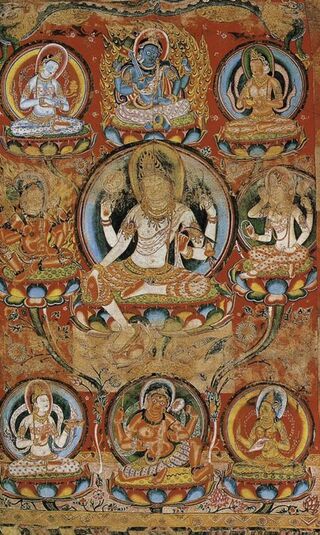
Item: Avalokiteshvara (Bodhisattva & Buddhist Deity) - Amoghapasha (Unfailing Lasso)
| Origin Location | Central Asia |
|---|---|
| Date Range | 800 - 899 |
| Lineages | Buddhist |
| Material | Ground Mineral Pigment on Cotton |
| Collection | Guimet Musee National |
Alternate Names: Lokeshvara Avalokita Lokanata Lokanatha Mahakarunika
Classification: Deity
Appearance: Peaceful
Gender: Male
Amoghapasha, Five Deities from the Sanskrit text Arya Amoghapasha Kalparaja.
Amoghapasha, which means unfailing lasso, refers to an unfailing compassion like a lasso which brings all sentient beings out of suffering and into a state of happiness leading to enlightenment. Amoghapasha is a complicated deity subject in Tantric Buddhist iconography. He is easily mistaken for Avalokiteshvara in most artistic depictions. The two deities are frequently conflated together by Western scholars. Sometimes Amoghapasha is described as a form, or emanation, of Avalokiteshvara and again at other times, such as with this painting titled Amoghapasha, a retinue figure while Avalokiteshvara is the central deity in the composition. It begs the question, why is this painting called the Five-deity Amoghapasha if the central deity is Avalokiteshvara? It all comes down to naming conventions in Buddhism. The very idea of a compassionate deity called Amoghapasha comes out of a number of Indian Sanskrit texts that all have Amoghapasha in the title. In these texts both Avalokiteshvara and Amoghapasha are described along with different appearances and functions for each. In consequence, the principal name for all of these forms of the two deities, regardless of which one of the two is at the center of a painting, are called Amoghapasha - mandala, meditation, or ritual.
The central figure is [1] Avalokita, white in colour, with four arms. The first right hand is held out in a gesture of generosity, the second holds a lotus flower. The first left holds a flower bud and the second holds a lasso.
In front, at the bottom center is [2] red Amoghapasha with one face and four hands holding a vajra in the first right hand and hook in the second. The two left hands hold a flower blossom and a lasso.
To the immediate proper right of Avalokita is [3] red Hayagriva, wrathful, holding a club and vajra in the right hands and the left in a fist and holding a flower blossom. He has a green horse head atop his own and is surrounded by flames.
At the top of the composition, behind Avalokita, is [4] black Ekajati, wrathful, with one face and four hands. In the right she holds a sword and club. In the left is an axe and lasso. She sits surrounded by a mass of orange and yellow flames.
To the proper left of Avalokita is [5] Bhrikuti, white in colour, peaceful, with one face and four hands. The first two right hands hold a mala, string of prayer beads, and the second held up in a gesture of song. The first left hand holds a trident and the second a flower blossom.
At the four corners of the composition are four offering goddesses. At the bottom right is the goddess [6] Gandha offering scented water in a white conch shell. At the bottom left is the goddess [7] Pushpa offers flowers on a flat gold plate. At the top left the goddess [8] Dhupa offers incense in a gold brazier with a long handle. At the top right the goddess [9] Dipa offers light and holds a gold lamp with a small flame licking upward.
There are a number of different Amoghapasha mandala configurations that still exist in the Newar and Tibetan Buddhist Traditions. There are also numerous solitary forms that do not have elaborate mandalas or retinue figures. The most common of these forms are typically depicted in Nepalese sculpture. They generally have one face and multiple arms, six, eight or ten, and are shown in a standing posture.
Sanskrit Source Text: Arya-Amoghapasa-kalparaja [Toh 686] (See Amoghapasha Outline Page).
View Identification Key:
1. Avalokiteshvara
2. Amoghapasha
3. Hayagriva
4. Ekajati
5. Bhrikuti
6. Gandha Devi
7. Pushpa Devi
8. Dhupa Devi
9. Dipa Devi
Jeff Watt 8-2009
Exhibition: Mandala, The Perfect Circle (RMA)
Thematic Sets
Buddhist Deity: Amoghapasha (Masterworks)
Subject: Greyscale - Figurative & General Composition
Buddhist Deity: Amoghapasha Iconography
Buddhist Deity: Avalokiteshvara Religious Context
Buddhist Deity: Avalokiteshvara Masterworks (Painting)
Buddhist Deity: Amoghapasha Five Deity
Buddhist Deity: Amoghapasha Main Page


